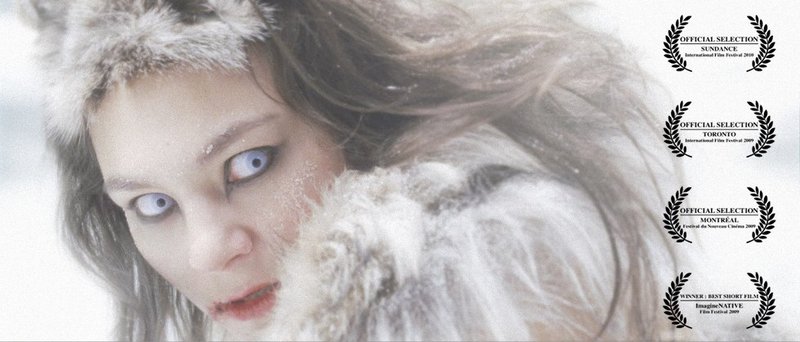 (please click on the image to link to the film)
(please click on the image to link to the film)
In the collaborative short “Tungijuq: What We Eat” (2010) we see a genesis of the eternal relationship between Inuit and hunting. This, in the words of the filmmakers (lead actor and Inuit jazz throat singer Tanya Tagaq, executive producer and Isuma co-founder Zacharias Kunuk, and directorial and screenwriting team Félix Lajeunesse and Paul Raphaël), is a way to “talk back to Brigitte Bardot and [the] anti-sealhunting lobby” (1)
The film itself in remarkably unlike previous output from Igloolik Isuma Productions – Kunuk’s Igloolik-based filmmaking collective that has gained international notoriety for its feature-length melodramas, including the Cannes Camera d’Or-winning Atanarjuat: The Fast Runner (2001). Atanarjuat was the first Inuktituk-language feature-length film and recounts a four thousand-year old Inuit legend, and its power lies in its ability to narrate from an Inuit perspective a story of emotion and conflict that transcends – and that also elucidates – the continuum of Indigenous lifestyles past and present.
While “Tungijuq” also takes on this same line of thinking, in contrast, this short film relies heavily on animation techniques and non-linear story-telling to portray the trajectory of life and death cycles through the lens of traditional Inuit hunting and eating. Tagaq, who plays the main character of the film, begins her metamorphoses as a shaman figure who takes the form of a wolf. Tagaq-as-wolf chases and hunts a caribou, which in turn transforms into Tagaq as a human-caribou hybrid form, who then dies from a wolf bite. Yet this one death does not end Tagaq’s transformation, as she transforms again, and yet again before the film closes with a shot of Kunuk and Tagaq eating a meal of seal’s meat after the hunt. Tagaq gently runs her fingers over the inside of her former seal self before taking a bite as she looks at the viewer with a smile. That the film begins and ends with a front angle close-up as Tagaq looking into camera adds to the many references to cycles, as each vignette transitions to the next and the next, reinforcing the idea that the story is ongoing.
Inuit survival has long depended on hunting animals, and this remains true in the contemporary circumpolar North as hunting participates in modern processes and channels of global trade. The European Union’s 2009 ban on seal products has had a major impact on the Northern sealskin trade as well as seal oil supplement and meat industries, despite the ban’s exception for Indigenous-made products, as it has effectively eliminated the market for pelts and other products globally.
The Canadian federal government (joined by the Norwegian government) has launched a World Trade Organization legal challenge against the ban, arguing that this commercial industry is humane and sustainable. As Anthony Speca for Northern Public Affairs Magazine puts it, “Having adopted its ban explicitly to cripple the commercial sealing industry and destroy the value of seal pelts, the EU appears to condone the Inuit seal hunt merely as a cultural holdover from a mythical Arctic innocent of the profit motive”(2). Rather, Tungijuq’s political message is tied to its cultural message: in the North, hunting and living are eternally connected, even in historically changing contexts.
Isuma’s co-founder Norman Cohn once described Kunuk as “a hunter who happens to make movies” (3). In the case of Tungijuq, hunting and filmmaking merge in a shared story of survival that is about much more than sustenance, while at the same time the film features food and eating in a way that makes them just as crucial to the story as hunting. Of course, Inuit communities traditionally use the parts of the animals they do not eat, whether these are skins for clothing, shelter, or trade, or in the case of seals, oil to light a qulliq (seal oil lamp) or to export as supplements containing higher contents of omega-3 fatty acids than salmon. Hunting for food is particularly important to offset the high cost of importing food goods to Northern communities.
The story nourishes the relationship between Inuit and the animals they have historically relied upon for food, and rests quietly in the face of narrow perceptions about sealhunting’s cruelty that are typically raised from a non-Inuit perspective. The anti-seal hunting lobby is a position based on a moral claim, disembodied from political, economic, and cultural experience. In a particularly pointed and knowingly unimpassioned statement, president of the land claims group Nunavut Tunngavik Inc. Paul Kaludjak says, “We don’t really care about how the outside world thinks about how we eat our country food,” illustrating the gap in understandings about what the sealhunt represents (4).
Calls to end the sealhunt in the circumpolar north, however, are often brimming with emotion, including Bardot’s, who, at a 2006 press conference in Ottawa insisted that “she couldn’t watch” video footage of a hunt that was provided for the event’s audience (5). Tungijuq encourages us not only to watch the hunt as one moment in the transformative life between human and non-human animal but also to try and understand the importance of this relationship beyond the singular act.
— Erin Morton & Taryn Sirove
Erin Morton teaches in the Department of History at the University of New Brunswick in Fredericton, Canada. Her research broadly examines categories and experiences of art and culture as being determined by and determining liberal capitalist modernity. She has published widely on historical and contemporary visual and material culture in Canada and the United States in such collections as Global Indigenous Media (Duke University Press, 2008) and journals as Utopian Studies and the Journal of Canadian Art History. She is currently working on two books with McGill-Queen’s University Press, the single-authored monograph Historical Presenting: Placing Folk Art in Late Twentieth-Century Nova Scotia, and the co-edited volume, Negotiations in a Vacant Lot: Studying the Visual in Canada.
 Taryn Sirove is a postdoctoral fellow at Carleton University in the Department of Law and Legal Studies, where she combines her interests in media arts histories and cultural studies of law. Sirove received her PhD from Queen’s University in Visual and Material Culture, and has completed curatorial projects for A Space Gallery and Vtape Distribution Centre. She has published collaboratively with Dr. Erin Morton in the film journal Post Script, and in the collection Global Indigenous Media (Duke University Press, 2008). Sirove will contribute a book chapter on media arts censorship to LIFT and Toronto’s Images Festival’s forthcoming collection entitled Explosion in the Movie Machine: Histories of Toronto Moving Image Culture.
Taryn Sirove is a postdoctoral fellow at Carleton University in the Department of Law and Legal Studies, where she combines her interests in media arts histories and cultural studies of law. Sirove received her PhD from Queen’s University in Visual and Material Culture, and has completed curatorial projects for A Space Gallery and Vtape Distribution Centre. She has published collaboratively with Dr. Erin Morton in the film journal Post Script, and in the collection Global Indigenous Media (Duke University Press, 2008). Sirove will contribute a book chapter on media arts censorship to LIFT and Toronto’s Images Festival’s forthcoming collection entitled Explosion in the Movie Machine: Histories of Toronto Moving Image Culture.

That was a beautiful short film.
It is so upsetting to me that people are incredibly vocal about things like the seal hunt, which are cultural practices necessary for sustaining life via procuring food, yet are completely content to ignore the infinitely more horrific and cruel way that we treat animals raised and slaughtered in factory farms – meat that is unnecessary for survival and the number one (NUMBER 1!!!) cause of greenhouse gasses.
We’re content to ignore the havoc we cause with our disgusting and cruel practices, yet those who have long fostered a sustainable practice when it comes to eating animals are shat on for it. Despite the fact that many videos showing the reality of factory farming (for example, Earthlings) are available for free online, people selectively tend to watch things like seal hunt videos and get outraged about it.
Killing another being for food is brutal no matter what. It’s a forcible death. But there are hunters who do it respectfully, and those of us who criticize while our mouths are full of animals treated in an irredeemable way from birth.
I mean come on. I’d like to see this video played side-by-side with footage of factory farms.